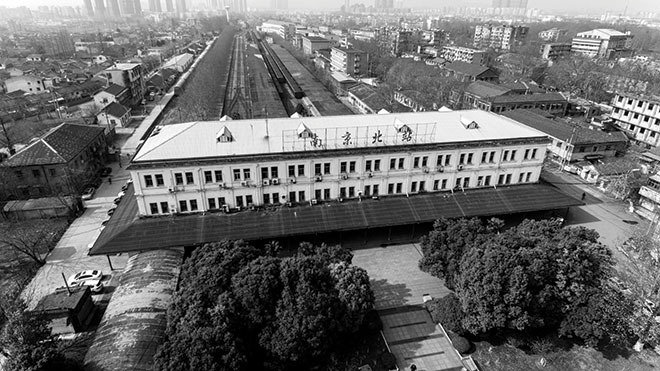As time travellers arrive in Nanjing, they might expect to find a Metro service ready to whisk them off to the suburbs, or possibly to destinations beyond the stars. Pods float above an elegant bridge over Xuanwu Lake waiting to be collected like futuristic “Boris Bikes”. Voice activated, they will get you to your Pukou home in a thrice, before automatically and unmanned returning to the nearest PodStop.
It is a shock to the system, for sure; not at all what they envisioned. No, to see how the future was really imagined in the past, any self respecting time travellers coming to Nanjing make their first pilgrimage present day Nanjing North Railway Station.
Located on Jinpu Lu in Pukou District, the station, known as the only hundred-year-old example in China that retains its historical features complete, is rated a major historical and cultural site protected at national level. As the terminal of the Pukou-Tianjin Railway, which was the main north-south artery for many more years, this was also the place that, amid much ceremony, welcomed Sun Yat-sen’s coffin on 28th May, 1929.
Until the opening of the Yangtze River Bridge in 1968, Nanjing North was a busy place, with many passengers alighting to cross the river by ferry before boarding another train to continue their journey from Nanjing West Station in the former Xiaguan District.
A plan announced in May 2015, decreed that restoration work would begin on the station and its surroundings. As of January, 2017, it would appear that a more accurate word for the “restoration” might be “abandoned”.
Yet, there is plenty evidence of care; it and the adjacent Pukou Ferry are by far the cleanest buildings around, in addition to probably being the oldest. However, it is when peeking through the windows into the waiting room of old that the time travel really starts happening.
In a way sufficiently haphazard that one wonders whether it was diliberate, numerous paintings in varying states of deterioration dot the waiting room’s floor, arranged, it would appear, to display one of the world’s oddest art galleries to whoever peers in the broken windows from outside.
The paintings reference imaginary people and places; they existed only in the artist’s imagination as they tried to picture a future world. It is obvious that these works were a product of pre-Cultural Revolution China; the Republician spirit is there but the influence of the then burgeoning Communist Party is also evident, simmering below the surface. This would emerge again 50 years later in the Party’s propaganda posters; different doctrine, but the same artistic sensibilities in paintings that serve up a vision implying a future China will not look disimilar to that which was to be written almost twenty years later in Aldous Huxley’s “Brave New World”.
Should style and degree of decay be anything to go by, there can be little doubt that these works date from the time the station was built. Perhaps they once adorned the platforms, looking down on lovers saying goodbye or men going off to war. Either way, it is almost certain that the works were commissioned to give the station a more modern, international feel.
If this is how preservation is served up for China’s historic railways, we’ll have three more portions, please. For Nanjing North Railway station could well be China’s most potent example of how the future looked a hundred years ago.
This article was first published in The Nanjinger Magazine, February 2017 issue. If you would like to read the whole magazine, please follow this link.









